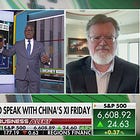Scott Bessent: The Fed’s New “Gain-of-Function” Monetary Policy
The Treasury Secretary says that overuse of nonstandard policies, mission creep, and institutional bloat are threatening the central bank’s monetary independence. There must be reform.
Don’t miss my appearance on yesterday’s “Making Money with Charles Payne”.
NOTE: In light of today’s historic — albeit belated and insufficient — FOMC meeting, I am republishing this important essay by our excellent Treasury Secretary Scott Bessent.
The right answer to reforming the Fed is best explained in this book on that subject by Ron Paul. Nevertheless, in the world we actually inhabit, Secretary Bessent’s thoughts are spot-on, needful, and hopefully soon-to-be-implemented by a better Fed Chairman, who — if it can’t be Steve Moore or Larry Kudlow — ought to be Kevin Hassett.
Take a minute to read Secretary Bessent’s thoughts. This is the reform we need immediately. We can come back for more after. — RDM
by Scott Bessent
September 17, 2025
As we saw during the COVID pandemic, when lab-created experiments escape their confines, they can wreak havoc in the real world. Once released, they cannot easily be put back into the containment zone. The “extraordinary” monetary policy tools unleashed after the 2008 financial crisis have similarly transformed the U.S. Federal Reserve’s policy regime, with unpredictable consequences.
The Fed’s new operating model is effectively a gain-of-function monetary policy experiment. The Fed’s adoption of large-scale asset purchases as a tool of monetary policy when its traditional instrument — the overnight interest rate — was at the zero lower barrier created severe distortions in the market, with unintended consequences. And it has disturbed the Fed’s unique independent role in the U.S. political system. Central bank independence is fundamental to the economic success of the United States.
The Fed must change course. Its standard monetary policy toolkit has become too complex to manage, with uncertain theoretical underpinnings and problematic economic consequences. Gain-of-function monetary policy must be replaced with simple and measurable policy tools to achieve a narrow mandate. Such an approach is the clearest and most effective way to deliver better economic outcomes and safeguard central bank independence over time.
Unconventional Monetary Experiments, Not Policy
In the aftermath of the 2008 financial crisis, the Fed was understandably determined to help revitalize the American economy. It had just successfully modernized its traditional responsibility as a lender of last resort, helping to stabilize the financial system. This role, as described by Walter Bagehot in Lombard Street (1873), is a time-tested function for central banks in managing liquidity crises. While the complexity of modern credit markets necessitated innovations in program design, the principles guiding the Fed’s intervention were well-worn.
Buoyed by its perceived success in combating the financial crisis, the Fed began placing increasing faith in its ability to steer the economy. This confidence was reinforced by growing frustration with political gridlock in Washington, which appeared unable to address the economic damage inflicted by the Great Recession. The mantra that “central banks are the only game in town” gained widespread traction amongst policymakers.
Against this backdrop, the Fed extended its liquidity tools into uncharted territory, repurposing asset purchase programs as instruments of stimulative monetary policy. This experiment ignored the fact that even the impacts of changes to short-term interest rates — a relatively well-developed and allegedly well-understood tool — are often unpredictable.
The challenges in assessing the transmission of monetary policy are magnified when it comes to unconventional policy instruments such as large-scale asset purchases, also known as quantitative easing (QE). These tools were designed to stimulate the economy through various channels, none of which are well understood. Lower long-term interest rates, in theory, would encourage borrowing for business investment and other productive activities that would raise real economic output. Higher asset prices driven by lower interest rates were expected to generate a “wealth effect” as newly flush consumers spent more, boosting economic growth.
Additionally, reducing the supply of government securities in the market was intended to push investors toward riskier investments, thereby stimulating greater economic activity through what is known as the “portfolio balance” channel.
However, the precision with which the Fed can gauge the impact of these tools remains extremely limited. Monetary economists have tried to quantify the impact of unconventional monetary policies in terms of an equivalent short-term interest rate. According to a leading model, the Wu-Xia Shadow Fed Funds Rate, the Fed’s adoption of unconventional tools during the 2010s pushed the effective nominal interest rate to as low as -3 percent by May 2014. Despite these deeply negative nominal interest rates, the U.S. economy never experienced the kind of nominal GDP boost that such a stance would have suggested.
Other scholarship has arrived at different conclusions. A 2017 paper from the Bank for International Settlements found that QE had a de minimis impact on real output, but a statistically significant impact on equity prices that was more than ten times the magnitude of the effect on real output. However, then-Fed Chair Ben Bernanke had no doubts as to the effectiveness of unconventional monetary policies, famously stating in 2014 that, “the problem with QE is it works in practice, but it doesn’t work in theory.”
The Fed’s confidence in its powerful new tools resembles that of a central planner who assures their subjects that the grand scope of their powers and their prescience will lead to inexorable prosperity. But despite Bernanke’s insistence, the mystery of the effects of QE — intended and unintended — remains.
Unpredictable Consequences in the Real World
One might think that all these new tools and the centralization of the U.S. financial market on Constitution Avenue would have given the Federal Open Market Committee greater visibility into the economy’s direction of travel. At a minimum, all those “gained functions” should have allowed the FOMC to more effectively steer the economy onto their desired path. That did not happen because the Fed simply does not comprehend how the new gain-of-function monetary policy works.



